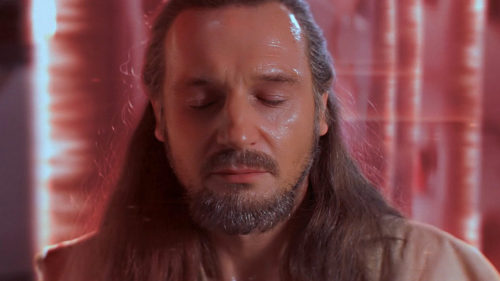#philosophyblr
Buddhism in Star Wars
Approaching his last moments, Qui-Gon Jinn does not dwell on the anxiety of fighting Darth Maul. Nor does he simply wait for the laser gate to open. He opens himself up to the Force, mindfully drawing himself to its will.
Read more here.
Post link
Learning to let go
This week we are investigating the placement of Buddhist philosophy in Star Wars! And soon we will release a full article.
Until then here is something to consider.
InThe Empire Strikes Back(1980) Luke Skywalker fails his initial training with Yoda on swamp-planet Dagobah. In a vision Luke sees himself in the helmet of Darth Vader (pictured). What does this vision mean?
Answer: Yes, Vader is a source of evil in the galaxy but Luke is too fixated on killing him; he becomes his suffering. Vader is the poster-boy for the dark side. He embodies giving into desire. To avoid this path and eliminate suffering in his own life—and find enlightenment—Luke has to extinguish his immediate human desire to kill Vader and find greater answers: he must resist what feels right now and transcendentally adhere to the will of the Force. Only then will he become strong enough to bring about the return of the Jedi Order.
In the end Luke tries to save Vader.
Can you let go, too? The dark side is always alluring—not just in a galaxy far, far away but here on Earth.
May the Force be with you.
Post link
The Mind in Indian Philosophy II: Self and World
Last time, in Part I, we discussed how our minds represent things under the limiting conditions of sensibility. We began with the arguments of Kant on this topic; his philosophy of mind has many similarities with some much-older classical Indian philosophy.
Today we discuss some Indian philosophy of the self.
According to some philosophers, limitations of ourselves limit our knowledge of the external world. The basic idea is that if you change as a definite person—or if you never existed at all—the objects you perceive change as well because how you think, dream, and speak about objects is disunified.
For Arindam Chakrabarti (author of Realisms Interlinked; pictured), subjects and objects are intimately connected. A single ‘I’ of a mind must unify experiences over time to give nature to external reality (Nyāya-school arguments). A stable self achieves unification of objects by sustaining an objective time-order, carrying them in a coherent world in continued experience. So if a mind substantively changes and the single-self perspective dissipates, the objects housed in prior experience lose their structure.
Chakrabarti claims the mind can track the world because what is real about the world has the very nature of being knowable. Antirealists disagree and say this would render reality a product of the mind—a claim realists want to avoid! Sidestepping this challenge, Chakrabarti argues that subjects and objects must both be real for there to be real objects.
So are persisting subjects—selves—real?
Abhidharma Buddhist Vasubandhu claimed selves reduce to entities called ‘dhamas’. But these selves only hold ‘conventional’ existences. Pudgalavādins go further: they argue for the actual reality of persons. Nāgārjuna, in contrast, denied the existence of any fundamental object at all, including the self.
If there is no persistent self, there is no stable reality. As per Hume’s bundle theory, selves are just bundles of properties coming together. Objects, then, are bundles of properties coming together as well, appearing to us differently each time in representation under the limiting conditions of sensibility.
So here’s a scary thought.
Look at something you love, say, your pet. Ask: have you changed from five years or even 10 minutes ago? If you have, you better start firming up your reality; else you may have just lost a pet. The upshot is at least you gained a bundle of properties—and again; and again …
Post link
The Mind in Indian Philosophy I: Before Kant
It was Kant who said, in Critique of Pure Reason, that ‘all objects of an experience possible for us are nothing but appearances’. What did he mean? Well, cognition requires intuition but intuition is limited: it presents appearances, not ‘things in themselves’.
In claiming so, Kant tied metaphysics to epistemology, appealing to a distinction between objects drawn from our conceptual resources and the things we cannot know.
‘[T]he transcendental object that lies at the basis of appearances […] is and remains for us inscrutable; for although the thing itself is indeed given, we just do not have insight into it.’
However, Kant, by a long stretch, wasn’t the first philosopher to argue along these lines. Roots can be traced to classical Indian philosophy. In the Nyāya, Vedānta, and Buddhist traditions, for example, the mind’s connection to the external world has long been questioned.
From science and in our own lives, we know that mental faculties create different ‘appearances’ between us. Apparently, on average, an orange object appears redder to males and grass is greener to females; boa constrictors have infrared vision; that dress is either gold and white or blue and black. However, perhaps there is a true nature of each of these things, even if it cannot be cognised and known (Kant).
According to Nāgārjuna (b. 150 AD; pictured), a Madhyamaka Buddhist, there isn’t. Reality is empty and by banishing ‘objective thought’ upon our reflections we’re able realise this ‘ultimate truth’.
This Madhyamakan route can still be noncommittal: through it we remain sceptical about the world, neither ascribing reality nor rejecting reality in our beliefs (a view which may have inspired Pyrrho).
According to many other philosophers, though, it is possible to conceive of real ‘things’, committing one to realism. It might just be that the mind only provides windows with restricted views (cf. Locke’s distinction of primary and secondary qualities).
With our descriptions of the world, like in physics, we might just track certain patterns and structures without truly understanding the ‘why’s of reality (e.g., particles can be waves and in infinite places at once).
What do you think?
(Painting [c. 1750]: Nāgārjuna with Mahasiddhas [cropped]. [Rubin Museum of Art])
Post link
Giveaway!
Hello again, folks.
We are back and we hope you are well!
We feel so bad for abandoning you. To compensate for our neglect we are running another giveaway. Here are the details.
The prize is a copy of Spinoza’s Ethics and all you have to do is like this post on Instagram. You have 48 hours. The winner will be announced via Instagram Story on Friday.
That’s it.
Until then!
The Human Front
Post link
Time for a break
Hello, everyone.
James here.
So perhaps this is bad news: we’re going on a short break from posting content. Hopefully, this will be for no longer than a month or so.
The good news, for me at least, is that I’ve had an abstract accepted for writing a book chapter on philosophy in Better Call Saul and I need time to complete it (whilst having a life, if I’m lucky).
What is reassuring is that we still have a stream of people who are interested in submitting work and who I always love helping. Moreover, many of our own ideas for The Human Front content already materially exist in draft form or on a long-ass schedule.
There just isn’t enough time in the world to do all of these things right now. Damn you, World! However, philosophical content is already in the oven to feed our empty stomachs upon our return.
Bear with us. We will be back.
S’all good, maaaaan.
James
(Pictured: Saul Goodman [Bob Odenkirk]. [Michele K. Short/Sony Pictures Television])
Post link
Patch Adams: Storms That Guide You
Today we give you with the following quotation from the movie Patch Adams (1998), starring Robin Williams as Hunter ‘Patch’ Adams (pictured), because … Sunday vibes.
In the film, a biopic, Adams chooses to become a doctor. His aim is to instil more humanity into the medical profession, particularly into how doctors communicate with and care for their patients.
However, Adams needed to realise his own humanity first, having attempted to end his life, before beginning his new mission, which is to make people smile.
‘All of life is a coming home.
‘Salesmen, secretaries, coal miners, beekeepers, sword swallowers—all of us—all the restless hearts of the world—all trying to find a way home.
‘It’s hard to describe what I felt like then. Picture yourself walking for days in a driving snow. You don’t even know you’re walking in circles—the heaviness of your legs in the drifts; your shouts disappearing into the wind. How small you can feel. How far away home can be.
‘Home: the dictionary defines it as both a place of origin and a goal or destination.
‘And the storm? The storm was all in my mind. Or, as the poet Dante put it: ‘In the middle of the journey of my life I found myself in a dark wood, for I had lost the right path.’
‘Eventually I would find the right path, but in the most unlikely place.’
Are you on the right path? Maybe you, too, need to be shaken by a storm first.
Post link
Simone de Beauvoir’s garden of meaning
What is existentialism? For Simone de Beauvoir (b. 1908) the discipline is a response to the human need to find a ‘place in a world turned upside down’. It cannot be explained succinctly. Still, let’s have a go.
Pyrrhus and Cineas
In her 1944 essay Pyrrhus and Cineas Beauvoir looks to explain humanity’s quest to find meaning by way of analogy.
Pyrrhus has a plan:
‘We are going to subjugate Greece first,’ says Pyrrhus.
‘And after that?’ asked Cineas.
We will vanquish Africa.’
‘After Africa?’
‘We will go onto Asia … ’
‘And after that?’
‘We will go on as far as India.’
‘After India?’
‘Ah! I will rest.’
‘Why not rest right away?’
According to Beauvoir, Cineas’ question haunts our projects. For why do anything? What’s the point? We’re only going to end up where we started.
However, it’s only Pyrrhus who leads an authentic life. Whereas many people fail even to question their lives, he directs himself towards goals, having the imagination to forge something for himself from the world.
Pyrrhus doesn’t leave to return home, where he started: he leaves to conquer; then to conquer again … Each time he decides a new end. Each time he ‘transcends’ his situation.
‘The paradox of the human condition is that every end can be surpassed, and yet, the project defines the end as an end.’
The garden
The values we draw from our projects are never intrinsic, ready-made, or universal. To believe they are is to possess bad faith.
‘By identifying himself with his sex, his country, his class, with the whole of humanity [or God], a man can increase his garden, but he increases it only in words … [T]he fly on the stagecoach claims he is the one who led the carriage to the top of the hill.’
We give the world meaning through our engagement with it, an act which is accomplished with freedom and subjectivity. We throw ourselves towards ends with uncertainty: the price of leaving the world of ennui and inertia behind us. But, by choosing the locations and the limits of our projects, we snatch ‘the world from the darkness of absurdity’.
This garden must belong to me; I cultivate it. It even transcends me when I die.
‘I am enclosed within it until death because that garden becomes mine from the moment I cultivate it.’
It matters that our values are not given to us. My garden cannot be merged with the sterile void of the Universe, a passive equilibrium.
Being is not fixed to things: being is fixed to itself in a mode of transcendence. Like Pyrrhus’ journey, projects don’t end: ends are surpassed by other ends. Conquer or rest: it doesn’t matter which you choose. Just choose!
⁂
‘Is that my business? What does India matter? And what does Epirus matter? Why call this soil, this woman, these children mine? I brought these children into the world; they are here. The woman is next to me; the soil is under my feet. No tie exists between them and me. Mr Camus’s Stranger thinks like this; he feels foreign to the whole world, which is completely foreign to him … The inert existence of things is separation and solitude.’
Post link
The Philosophy of Seasonal Affective Disorder (SAD)
Do you get SAD? No: not sad; SAD.
Seasonal affective disorder (SAD) is a form of depression which tracks seasonal patterns. As summer ominously draws to a close, those who are susceptible to SAD have to prepare themselves for the long struggle ahead through winter.
Beneath the clinical manifestations of SAD there may be something more existential in action, something which expresses a disconnection from the now-decaying world.
To quote Freud on his friend Rilke:
‘Not long ago I went on a summer walk through a smiling countryside in the company of a taciturn friend and of a young but already famous poet. The poet admired the beauty of the scene around us but felt no joy in it. He was disturbed by the thought that all this beauty was fated to extinction, that it would vanish when winter came, like all human beauty and all the beauty and splendour that men have created or may create. All that he would otherwise have loved and admired seemed to him to be shorn of its worth by the transience which was its doom.
Winter is coming.
Read more about SAD here.
(Photo credit: Karol Wiśniewski.)
Post link
Ontological pluralism
Harry Potter exists. He just exists in a different way to you; and the degree to which he exists is lesser than the degree to which you exist—or so the ontological pluralist might say.
Isn’t this absurd? Let’s take a step back and ask what we mean by ‘exist’. This is an important question of ontology which has massive ramifications for how we see the world. For perhaps existence has different strands.
Restriction
I’ll go first: something exists if it is real, that is, a feature of reality. But this circularity doesn’t clear up anything at all. What counts as real?
Most people feel comfortable in saying material things are real. Tables and electrons exist because they are physical. Fine. But what about everything else? We don’t want to unnecessarily restrict the domain.
Do numbers exist? What about the property of being red, the love of a couple, one’s gender, a shadow, and an instance of depression? Will you deny their existences because none is construed as physical? The lines are more blurred than you first thought.
Race
Consider the importance of these questions through the following example in social ontology.
Does race exist? Some claim that it doesn’t: that there is no scientific basis for dividing us by it. However, one potential consequence of this claim is that discrimination of racial groups isn’t real. For if we aren’t distinguished in race, who exactly is being discriminated?
By raising the bar of existence too high we cannot properly assert discrimination. But will we really deny discrimination’s existence simply because, biologically, the features of human individuals vary according to a sliding scale and not according to distinct racial groups?
A contrario, discrimination is formed in our minds and is present in our language and our decision-making: in how we talk to each other, in implicit bias, in governments spending less on housing and education and hospitals in certain areas, and so forth. History clearly tells us that certain groups of people are discriminated more than others.
To turn the problem on its head: race is real precisely because we perceive the differences between people in our minds.
Degrees of being
Contemporary metaphysician Kris McDaniel offers a compelling account of ontological pluralism in 2017’s The Fragmentation of Being, authorising different ‘modes’ of being. When invoked in language these modes are more restricted than the generic concept of existence and ‘analogous’ to each other (a concept borrowed from medieval philosophy). To quote Aristotle, ‘Being is said in many ways.’
That there are multiple modes of existence has a long history as an idea in philosophy. Aquinas didn’t believe that God and creatures exist in the same way and said mind-dependent objects are merely ‘beings of reason’. Similarly, Leibniz discerned the absolute existence of monads from the attenuated existence of everything else. Meinong defined two modes of real objects: concreta (e.g. physical objects) and subsistence (e.g. timeless facts about physical objects). Heidegger identified ways of being in Existenz (of creatures), subsistence (of abstract objects), readiness-to-hand (of equipment), and presentness-at-hand (of matter). Gilbert Ryle claimed ontological pluralism is motivated by the idea that it is ridiculous to claim that ‘exist’ is deployable for radically different things, such as God and the number two. You get the point.
Like his peer Ted Sider, McDaniel claims there are different ‘quantifiers’ for asserting existence with (philosophical jargon). These capture fictional characters as real abstract objects (with whatever our best theory is, according to Peter van Inwagen,à laQuine).Things in the past exist, too; so do other worlds and holes. They are all simply impoverished in their being. They are ‘beings-by-courtesy’.
If you still reckon this doctrine is too wild, think about existence as follows. Existence is like mass: an elephant and an ant each has mass but the former is more massive. Likewise, in some way, Harry Potter exists; he’s just not as real as you.
(Image credit: Brian Selznick/Scholastic.)
Post link
Celebrating diversity
Today we celebrate the diversity of our community.
Pictured are the flags of our contributors: Hong Kong, Japan, Philippines, Portugal, Slovenia, Turkey, United Kingdom, United States. It’s wonderful to imagine philosophy being created for The Human Front from around the world.
We haven’t asked our contributors to identify their genders. Though both men and women contribute, we’d like more diversity. (Get in touch!)
Thanks to Google Analytics, here are some statistics about our readership.
A non-exhaustive sample of 15,607 users revealed the following distribution of readers:
- United States: 5,370 (34.46 %)
- United Kingdom: 2,603 (16.70%)
- Canada: 823 (5.28 %)
- India: 638 (4.09 %)
- Australia: 614 (3.94 %)
- Philippines: 529 (3.39 %)
- Germany: 286 (1.84 %)
- Brazil: 202 (1.30 %)
- Netherlands: 193 (1.24 %)
- Turkey: 183 (1.17 %)
Other nationalities identified include: Japan, France, Spain, Italy, New Zealand, Sweden, Mexico, Indonesia, United Arab Emirates, Denmark, China, South Africa, Pakistan, Singapore, Ireland, Greece, South Korea, Norway, Poland, Thailand, Austria, Portugal, Hong Kong, Romania, Argentina, Malaysia, Slovenia, Egypt, Russia, Belgium, Bangladesh, Finland, Nigeria, Kenya, Vietnam, Israel, Hungary, Serbia, Puerto Rico, Taiwan, Ukraine, Bulgaria, Switzerland, Saudi Arabia, Chile, Colombia, Czechia, Morocco, Croatia, Nepal, Ghana, Slovakia, Georgia, Algeria, Latvia, Albania, Estonia, Peru, Sri Lanka, Ethiopia, Bosnia Herzegovina, Lithuania, North Macedonia, Tunisia, Ecuador, Iraq, Malta, Trinidad & Tobago, Zambia … plus 70 more.
Using Instagram Insights, a 90-day sample revealed that, of 9,250 users, 64.6 % were men and 35.4 % were women.
The breakdown of age was as follows:
- 13 to 17: 1.8 %
- 18 to 24: 35.4 %
- 25 to 34: 44.8 %
- 35 to 44: 11.3 %
- 45 to 54: 3.9 %
- 55 to 64: 1.5 %
- 65+: 1.4 %
Thank you for being part of this journey, wherever you are in the world, whatever your gender is, and however old you are!
Post link
Schopenhauer on Social Media
‘[T]hey reverse the natural order, regarding the opinions of others as real existence and their own consciousness as something shadowy, making the derivative and secondary in to the principle, and considering the picture they present to the world of more importance than their own selves. By thus trying to get a direct and immediate result out of what has no really direct or immediate existence, they fall in to the kind of folly which is called vanity.’
Read more here.
(Artwork by Dijana Vilić.)
Post link
The Philosophy of Moon
Moon (2009) is a quietly disturbing sci-fi. Through the crisis of one man we are asked to ponder some deep philosophical questions, not just about him but about ourselves—all without being bombarded with unnecessary action.
Sam Bell’s reality is shaken to its core in Moon. Instead of disregarding an event as a glitch and moving on, Sam follows the scent of suspicion to agitate and uncover something bleak. He marches out to the Moon’s silent and eerie surface and uproots it—for the sake of truth.
Uncomfortable and confounded by the answers he receives, bothered by his subsequent physical and mental decay, we can only watch on and ask: ‘Wasn’t darkness better than the truth?’
⁂
Read more here. There is plenty of philosophy to find therein: ethics, metaphysics, and existentialism. Expect discussions of human cloning, personal identity, and purpose.
Post link
The ethics of cloning
(Pictured: Dolly the sheep with her Scottish Blackface surrogate mother. One mother wasn’t enough for Dolly; two others helped bring her into existence, providing the egg and her DNA. Born in 1996, Dolly died in 2003 of a fairly common kind of lung cancer in sheep. She nonetheless lives on (in stuffed form) at the National Museums Scotland, close to home.)
Here’s something to think about in preparation for our next article: how ethical is cloning? Let’s start with non-human animals.
Allow me to introduce Dolly the sheep (left). Born to three mothers (one of whom is on the right) in Scotland in 1996, Dolly was the world’s first ever mammal clone. In the UK cloning for the purposes of scientific research is legal upon application.
But in the aftermath of the Dolly’s cloning The European Union deemed the process to be highly controversial. Representatives said ‘the border was too close between animal cloning and cloning on human being[s]’—the ‘slippery slope argument’.
So human life is too precious to clone; animal life is not? In fairness, self-awareness means cloning threatens our existence in special ways. For example, if you were cloned, there wouldn’t be two of you: such a claim would be a contradiction. There is only one you, to whom no one can be identical. But while a clone cannot share your unique identity and your future experiences, they will be fighting for the same identity as you: a stirring thought. Plus there are ethical concerns even with cloning at the primitive stage of human development. These include the ‘death’ (destruction) of many embryos, which are given the moral status of beings, and steps towards eugenics.
However, there are several avenues down which human cloning serves tangible benefits to society. Cloned embryos can be used to create cells in the development of treatments for currently incurable diseases. Reproductive cloning offers hope of parenthood to infertile individuals, same-sex couples, and couples who cannot produce together, enhancing their dignity and familial liberty and bypassing the need for cell donation.
With science we look for ways to design better quality of lives, perhaps at a moral cost. After Dolly the European Union conceded there’s a debate to be held around human cloning for the purposes of medical research. And there’s precedent: in the US human cloning isn’t completely illegal, depending on where you are, and in the UK experimental stem cell research for treating diabetes, Parkinson’s disease, and Alzheimer’s disease is legal, as is three-person in vitro fertilisation.
We continue to foresee ways in which cloning will affect our moral outlooks (e.g. in fiction) and, eerily, who we think we are. The reality of human cloning may be far off. But that won’t stop philosophers, story writers, and us from debating moral issues now in preparation for such a time.
Post link
Condensed Matter - an Interview with Sam Kimpton-Nye
In our interview with Sam we discussed his new metaphysics and philosophy of science podcast, Condensed Matter; tips for getting into philosophy; the fictional character he identifies most with; and more.
Read our interview with a philosopher here!
Post link
‘It just is, and we just are, at least for a little while. There’s no compelling reason why any of it or all of it should be coherent.’
‘Otherworldly Visitor’ — a short story by Dylan Ngan.
Post link
Parts and wholes
(Pictured: ‘Sunday Morning’ (Philippe Faraut). Are the statue and the clay the same or different things? Why?)
Parthood has puzzled metaphysicians for a long time. How are parts of things related to whole things?
Take an object, say, a table. It has parts: wood, atoms, subatomic particles … Why is it the case that there is a whole thing called a table as well? The mereological nihilist claims that there are only fundamental parts (‘simples’ or ‘atoms’) merely arranged ‘table-wise’.
Yet philosophers of classic mereology offer some arguments we may want to consider before we subscribe to such a view. For example, there is composition, a mereological fusion of many parts (e.g. a cocktail); group membership (e.g. sports team); and constitution, a one-one relation between co-located objects, which takes us to an interesting example …
The statue and the clay
TakeJJ Thomson’s example of a statue made from clay. The statue is one object; the clay from which it is built is another. The problem is that two objects seem to occupy the same space at the same time, upsetting the monist :’(
However, according to pluralism, it can be okay to accept this situation because the two have different identities.
Buthow? Well, we could use the concept of time to say that whereas the lump of clay appeared at t1, the statue came into existence at t2. We could also reference additional features the statue has (like ears), its aesthetic value (beauty), or some defining property.
Reversing intuition
Parthood follows intuition. In language we often tacitly suggest that there are ‘proper’ parts to things (e.g. ‘grains of sand’ and ‘organs’) which make up wholes (e.g. ‘a heap of sand’ and ‘an organism’), not the other way round.
But why let our dodgy common sense rule how we think the world is? We might instead talk of wholes first—wholes which possess emergent properties that parts as mere aggregates do not.
We might be tempted to believe in ‘gunk’: that all constituents of the Universe are infinitely divisible: that parts have their own parts, which have their own parts, and so on.
But then in what sense is a thing—such as a table—really a thing? Is there anything? If there is, where is the line? Does identity depend on the spatial proximity of its parts? Unscrewing a table leg ever so slightly, does the table’s identity change? Why more so than throwing the leg over the fence and onto my neighbour’s garden? The argument for proximity feels weak.
A final thought
As a metaphysical relation, parthood putatively comes as many modes. There is a part-whole structure to a statue and clay, to a set of prime numbers, to an espresso martini, to a fact and its constituents, to spacetime and its regions, to an immaterial soul … Why? How?
Reality is weird.
Post link
Does Physics Rule the Sciences?
Here’s one reason why it may not:
Every biologist is, at heart, a chemist.
And every chemist is, at heart, a physicist.
And every physicist is, at heart, a mathematician.
And every mathematician is, at heart a philosopher.
And every philosopher is, at heart, a biologist.
Read more here.
Post link












![Schopenhauer on Social Media‘[T]hey reverse the natural order, regarding the opinions of others as r Schopenhauer on Social Media‘[T]hey reverse the natural order, regarding the opinions of others as r](https://64.media.tumblr.com/b67fae4194cfa3d77d4f70d7d8cd9ecd/c91cb60a7f5d7d39-d2/s500x750/5ef0af23cb0ed332713819e8fc9282e14f27f96c.jpg)





